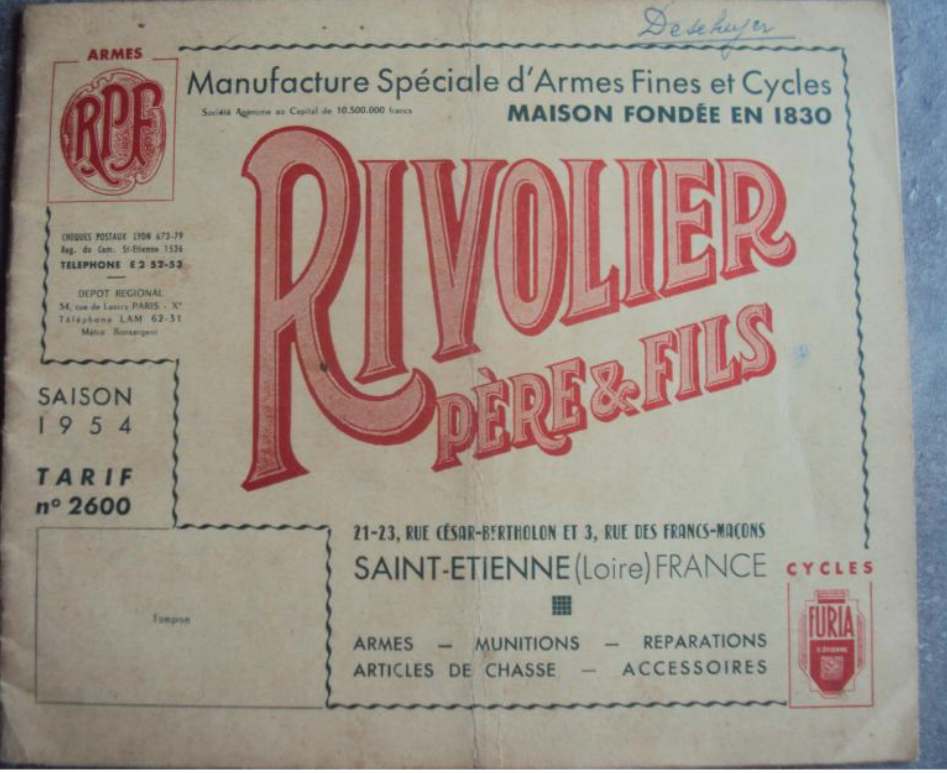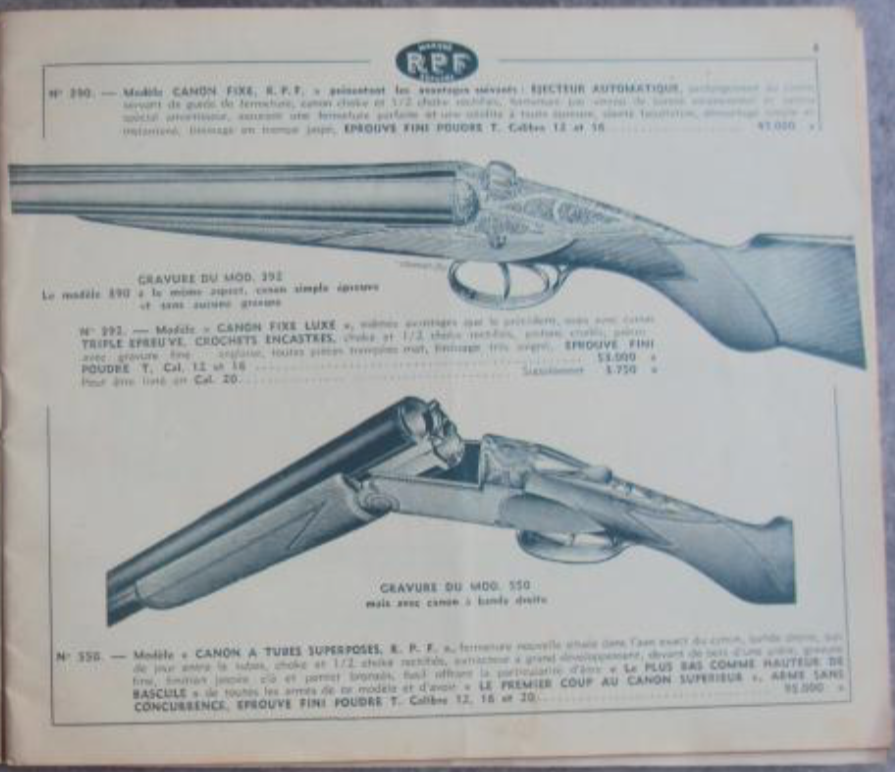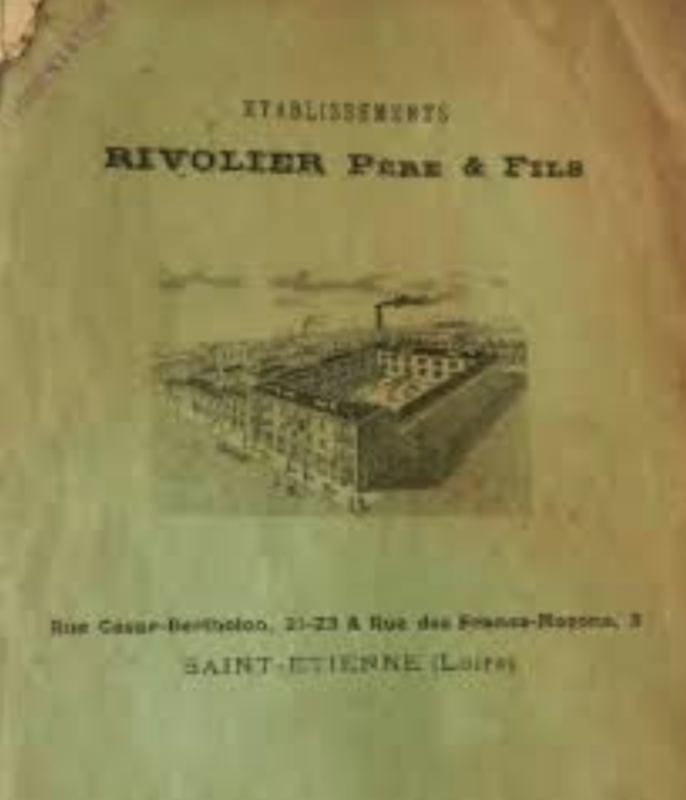Hello,
A member on shotgunworld.com recommended I pick the brains of you lot.
I recently picked up a so called "Belgian guild gun" over/under 12g, but after taking it apart I now realize most of the parts are from France and it's likely a french guild gun. I assume the seller was grossly misinformed.




I'm interested in learning anything I can about this recent purchase. I'm not interested in determining/justifying it's value as much as I am uncovering it's history and seeing if anyone else has a similar shotgun.
Anyone have an idea on a rough manufacture date/decade? I'm having a hard time finding specific information on anything that looks like this particular shotgun or other over/under guild guns. Most information I can find is on SxS french shotguns.
I've done as much research as I can crawling this and other forums. This is what I know:
Marked RPF on receiver for "Rivolier Pere et Fils" or "Rivolier Pere & Sons"


PT with crown on breach

CMR with (RPF) under the bottom barrel

"Portee Garantie P. Delalle"

Top and bottom barrel marked with the same St. Etienne proof and 18.4 65 (65mm) and there is a number of 5556? Also, more RPF and PT crown marks. There is also an unreadable mark that just looks like a barcode on the metal that joins the two barrels.

Any additional insight or info regarding this shotgun's history would be much appreciated!
Also, curious what i need to look for when determining if this shotgun is safe to shoot. I will be using RST 12ga., 2 1/2", Lite, Vel. 1175, 1 oz., 7 1/2 shot loads. Lockup is super tight and I don't see any signs of bulging or honing or good-ole-boy gunsmithing.
It's very difficult to date French shotguns. Unlike most European countries, the French proofhouse does not use a date code. And you don't see a lot of French OU's. You'll certainly see more Belgian OU's that bear a superficial resemblance to that gun than you will French ones. Not a surprising bit of confusion if someone doesn't know proofmarks.
That gun has the double St. Etienne proof. And its range is "guaranteed"--which is just a bit of advertising. Other than that, pretty standard French proofs. +
Re the Peugeot link: I've seen a few Peugeot sxs. Owned one several years back, and I have a friend who now owns one. But I've never seen a Peugeot OU.
Interesting that it's a 12 gauge...had I not seen the bore dimensions and saw that it was a French gun, I would have just assumed it was a 16. Based on my limited observations, it appears the French were very big on the 16 gauge. Either way, that's a nice gun and I especially enjoy the rounded receiver bottom. I bet it's very nice to carry. Balanced well? What does it weigh?
Both those previous lines posted by Raimey had some good fundamental information on RPF (and on Peugeot guns). Rivolier was no "guild gun;" he was a very prominent industrialist with his own factory and of course was head of the Saint Etienne Proof House for years; there is a street named after him in Saint Etienne. To get to the heart of the matter on those lines, though, you'll have to wade through some rants, all too repetitive here unfortunately, which are "embarrassing." The photo of the 1911 Rivolier catalog posted in the line has been kidnapped and held for ransom by photobucket. Here is a 1954 Catalog though with an O/U pictured. Rivolier is still in business and you can buy an O/U from them (though I suspect it's made in Turkey).

 image hosting no registration
image hosting no registrationI believe Boss invented the o/u about 1902?. French picked up on it fairly quickly I suppose. Here is a line about a 1930's Saint Etienne O/U where we managed to identify, the maker of the gun, the maker of the barrels and the retailer who sold it...again the really interesting photos have been kidnapped.
http://www.doublegunshop.com/forums/ubbt...2782#Post452782The photos won't load for me at my current location. But since it's an o/u and it's cambered for "65"...it's after 1912. As we established previously, Saint Etienne went from measuring chambers in mm to cm in 1889 and back to mm in 1912. (photos and records on that line, "dating early 20th century French shotguns" have also disappeared).
Here are a few Rivolier O/U's for sale on Naturabuy.Fr..France's "gunbroker"...all pretty new....and I suspect Rivolier retains their records.
https://www.naturabuy.fr/Fusils-Superposes-Rivolier-critere-23015.html1911 Catalog cover. Look up Jean-Baptiste Rivolier.

It certainly seems to be an interesting shotgun and I’m really enjoying the research into it’s history. I’m not new to firearms, but I am new to double guns, so this is all very exciting. Not 100% sure where a shotgun should balance, but it seems to be right at the break point just forward of the trigger guard. Weight is just over 6 pounds. It feels balanced, so that’s what matters. Thanks for replying!
Raimey is a good dude. Put me on the right path and I really appreciate it. Thanks for the reply and the information. A lot to digest and a lot more to look into. The bickering on this forum doesn’t help in that regard. Still, lot of great info on here.
Raimey suggested I contact Rivolier to see if they have any insight to offer, so I’ll be doing that. Surprising to learn that this “Belgian guild gun” isn’t Belgian or a guild gun. Whatever it is, it’s been fun to research, which easily justifies its price, to me.
Any idea if the barrels are choked? My gut reaction is they are both cylinder bore.
Keep the info coming, this is a blast. New shells from rst arrived today. After a proper cleaning I’ll be taking it out for some sporting clays this weekend. If I return with all 10 fingers, then I’ll provide an update.
Thanks again for the historical insight. Much appreciated
No indication of choke. No requirement for it to be marked on French guns. I'd be very surprised if both barrels are cylinder. Something like that--or even one barrel rifled (not for slugs, but for greater shot dispersion)--is typical of guns made specifically for woodcock hunting. But those guns also usually have very short barrels. 24" or so. But a lot of French guns with longer barrels come with quite a bit of choke--maybe even more than you want.
Shooting RST shells, your fingers should survive. You might even want to try some of their lighter loads if you find the recoil uncomfortable.
areyouawake,
The term "Guild Gun" is a misnomer anyway, what they really are, are guns that were made by name makers for "the trade". In other words, they were sold to be marketed by someone else. Sometimes they were marked with a marketer's name, and often left unmarked.
Mike
Didn't get a chance to pattern the shotgun to estimate what the fixed chokes might be, but I did test fire it and shot a round of trap.
First shots (safety first):
https://youtu.be/CD-p9GfVK-gSeems to shoot really well.
Also got a response from Rivolier:
"Dear Sir,
This shotgun was sold by our firm in the 50.s .
The gun is a French design, made in France, prooftested in the city of Saint-Etienne.
I do not believe we actually made it. Most probably only the barrels and the finishing.
Will try to see if I can found some more info but we have very little of archives from this period."
Not sure what to think of that response, seems a little confusing.
The hunt for more information continues.
Excellent video...Notre Dame??
The 1954 Rivolier catalog entry looks remarkably similar to your gun. Larry and Ted can probably explain the twists and turns of the Saint-Etienne manufacturing hydra at the time - which would be only rivaled by the Birmingham-london intertwining of 1,000's of artisans in the 1800's. I would think the actions probably were contacted for and perhaps finished by Rivolier..as were the barrels...etc. That is the "guild" part of Saint-Etienne.
The only way to get closer to who made what would be to compare initials on various parts of the gun with this list of Cnamber of Commerce firms involved in the gun trade in Saint-Etienne about 1950...which we've posted before but never gets old....and as the compiler admits...is only a fraction of the artisans engaged in the trade at the time (chiffre inférieur à celui inscrit à la Chambre des métiers).
La liste de la Chambre Syndicale des fabricants d’armes de 1948-1951 compte 105 adhérents, chiffre inférieur à celui inscrit à la Chambre des métiers, mais qui permet de trouver les plus représentatifs de la corporation dans cette longue liste classée par ordre alphabétique :
Alloni, 12 boulevard Valbenoîte ;
André et Cie, 14 place Tardy ;
Automoto, 38 rue Gutemberg ;
Balp, 3 Cours Victor Hugo ;
Bancel Marcel, 17 rue Louis Blanc ;
Basson, 13 rue du Grand Gonnet ;
Berger Louis, 60 rue Mulatière ;
Bériola P., 13 rue Louis Blanc ;
Bergeron Louis, 7 rue Desflaches ;
Bertois Frères, 40 rue des Armuriers ;
Blanchard-Grange, 67 rue Antoine Durafour ;
Blondeau, 7 place Villeboeuf ;
Bonnard, 34 rue du Musée ;
Boucher, 12 rue Jean-Baptiste David ;
Bouniard et Barrière, 17 rue de l’Epreuve ;
Boyer A., 62 rue du 11 Novembre ;
Breuil Jean (canonnier), 13 rue Montesquieu ;
Breuil Claude (canonnier), 4 rue du Rozier ;
Brenier & Cie, 68 rue Antoine Durafour ;
Bretton René, 6 Cours Fauriel ;
Canonnerie Stéphanoise, 13 rue du Vernay ;
Celle Claude, 5 rue Emile ;
Chambon Frères (remplacé par Jean Luquet), 38 rue Jean-Baptiste David ;
Chanson Jean, 40 rue Badouillère ;
Chapuis, 11 rue Basse des Rives ;
Charlin, 18 rue Béranger ;
Chartron, 3 place Desnoëtte ;
Chataing & Durand (mécanique), Saint-Bonnet-le - Château ; Chaussadis, 50 rue Jean-Baptiste David ;
Chausse Claude, 21 rue Charles Rebour ;
Chausse (jeune) 9 rue Charles Rebou ;
Chavot (canonnier) 34 rue Clément Forissier ;
Chevillard, 8 rue du 11 Novembre ;
Courtial et Debraye, 14 rue Jean-Baptiste David ;
Constant Pierre (secondé par son fils Jean-Marie, Saint-Maurice en Gourgois (Loire) à qui succèdera son fils Pierre ;
Damon, 7 rue des Francs-Maçons ;
Darne Régis, 71 Cours Fauriel ;
Darne Francisque, 69 Cours Fauriel ;
Diard, 16 rue Clément Forissier ;
Donnet et Racodon, 31 rue des Armuriers ;
Douplat Frères, 38 rue Badouillère ;
Dupont, 11 rue Cuvier ;
Emonet, 12 rue Pierre Termier ;
Escot et Allègre, 6 place Villeboeuf ;
Faure Joseph, 19 rue des Armuriers ;
Faure Henri, 10 rue Clément Forissier ;
Faure Victor, Le Bois d’Avaize ;
Faure Alphonse, 17 rue Claude Delaroa ;
Fayard, 77 rue Antoine Durafour ;
Foussard Lucien, 7 place Villeboeuf ;
Garnier Raymond, 55 rue Claude Delaroa ;
Gaucher Jean, 12 rue Docteur Cordier ;
Gaspard & Cie, 4 Cours Fauriel ;
Gautey, 20 rue Ferdinand ;
Gerster, 61 rue Michelet ;
Giraud Louis, 18 rue Charles Rebou ;
Giraudet, 22 rue de Terrenoire ;
Giraudon, boulevard Poincaré ;
Gonon & Portafaix, 8 rue Villeboeuf ;
Grange, 13 rue des Armuriers ;
Guichard Henri, 66 Cours Fauriel, à qui succèdera Georges Granger ;
Guichard Maurice & Cie, 20 rue Montferré ;
Guignand & Pailleux, 76 rue Antoine Durafour ; Guillot, 11 place Villeboeuf ;
Heurtier (canonnier), 28 rue Clément Forissier ;
Humbert, 52 Cours Fauriel ;
James (canonnier), rue du Cimetière ;
Janisson, 28 Cours Fauriel ;
Jay Michel, rue Antoine Durafour ;
Jeay Georges, Le Grand Quartier à Sorbier ;
Jeury Victor, 24 rue Badouillère ;
Lasherme, 99 rue Antoine Durafour ;
Laspoussas-Driol & Cie (repreneur de Berthon et Didierfusil devient S.I.F.A.R.M.), 8 place Villeboeuf ;
Latcher Léon (repris par Plotton & Barret), 131 rue Antoine Durafour ;
Leyre Pierre, 30 Cours Fauriel ;
Maisonnial Aimé, 13 rue Clément Forissier ;
Manufacture Française d’Armes et de Cycles, Cours Fauriel ;
Manufacture Nationale d’Armes, 2 rue Javelin Pagnon ;
Marnas, 13 rue du Rozier ;
Marsault, 6 boulevard Valbenoîte ;
Martin-Dubost, 38 rue Badouillère ;
Mathieu, 25 rue Badouillère ;
Maumey Jean-Baptiste, 35 rue Mulatière ;
Meunier, 7 rue Jean-Baptiste David ;
Montagny Aîné, 48 rue Gambetta ;
Montcoudiol Lucien (Mécanique), Saint-Bonnet-le-Château ;
Odegaard, quartier de Beaulieu ;
Oriol Père & Fils, 58 boulevard Valbenoîte ;
Oriol (canonnier, 22 rue Rouget de l’Isle ;
Pascal, 7 rue Pierre Blachon ;
Pelletier Yves, 35 rue Mulatière ;
Peugeot, 46 rue Gutemberg ;
Philippon Marcel Père & fils (repreneurs d’Autechaud & Bonnavion), 17 rue Pierre Termier ;
Piat, 22 Cours Gustave Nadaud ;
Picard-Fayolle, 42 rue du Vernay ;
Pichon, 31 rue Césard Bertholon ;
Plotton & Barret, 96 rue Antoine Durafour ;
Picot Frères, 10 rue Jean-Baptiste David ;
Merley & Pouly (canonnier repreneur de Fanget), Andrézieux ; Mondiale, 2 Cours Fauriel ;
Preynat, 21 rue des Armuriers ;
Ressayre, 8 Boulevard Valbenoîte ;
Rey (successeur de Brun-Latrige), 7 Cours Fauriel ;
Reymond, 40 rue Désiré-Claude ;
Ribe Léon, 104 rue Antoine Durafour ;
Ribeyre, 60 rue Mulatière ;
Rivolier Père & Fils, 21 rue Césard Bertholon ;
Roullier-Baume, 4 bis rue Badouillère ;
Roux Louis, 3 rue du Vernay ;
Sabatier, 31 rue du 11 Novembre ;
Sabot Francisque (canonnier), 67 rue Césard Bertholon ;
Sabot Joannès, 14 rue des Francs Maçons ;
Saillant Prosper, boulevard Valbenoîte ;
Salanon, 21 chemin des Accacias ;
Saunier, 3 rue Jules Vallès ;
Sauvinet, 31 rue Césard Bertholon ;
Sélect-Armes (Victor Jourgeon), 103 rue Antoine Durafour ;
Seytre-Montagny, 68 rue Mulatière ;
Sigaud Fils, 56 Cours Fauriel ;
Soleilhac, 12 rue des Armuriers ;
Soulier, 83 rue Antoine Durafour ;
Staron, 14 rue des Francs-Maçons ;
Société Générale de Mécanique, 6 Cours Fauriel ;
Société Moderne de Fabrications Mécaniques (Rouby & Montuclard), 56 rue Tarentaize ;
Thivillier, 4 rue des Armuriers ;
Tissot, 8 rue Tréfilerie ; Tournaire, 4 rue Arago ; Vacher, 2 rue Jean-Baptiste David ;
Vassal (remplacé par Gérard Geffroy), 13 rue Franklin ;
Verdiell, 16 rue de Champagne ;
Verney-Carron, 17 Cours Fauriel ;
Vérot, 36 Cours Fauriel ;
Villebonnet, 61 rue Liogier ;
Zavattero, 24 rue Jean-Claude Tissot.
source: Forissier
Der Ami,
What is a 'guild gun'? I was always under the impression is was a gun made by an apprentice as a 'test to display his learning and craftmanship' prior to being accepted into the guild.
Your explanation is new to me.
Tamid,
The majority of unmarked guns are as I described. I cannot state with absolute certainty that none of them are as you describe. The only one I had my hands on that I know for a fact was built for a "Master's Certificate" was built by my German gunsmith friend Walter Grass who got his certificate at Heym, and to whom I refer from time to time. It was marked. To get a "Masters Certificate", in those days, they had to exhibit the requisite skill in two areas. Another friend I speak of from time to time was Helmut Kerner( Emil's grandson) who did his test at Meffert, one of his skills was action filing. To show his skill, he had approval to file a square block of steel to 1 cm thickness, and starting with a small drilled hole, file the hole to a square precisely 1cmx1cm, using only a square, caliper and files. Additionally, he filed a 1cmx1cmx1cm cube that fit into the hole at all orientations, without allowing light through ( his other skill was stock making). From this we know that not all "Masters" built a gun, anyway. Also I tried very hard to buy Walter's, many wears after he built it. He wouldn't think of letting it go, and I'm sure many of the others wouldn't either. Mr. Heym, gave Walter the raw parts for his gun,but I can understand that there might be some cases where the parts might have been acquired, and paid for by selling the gun, but I don't know this. There were a great many made "for the trade", however, and left unmarked.
Mike
Der Ami,
What is a 'guild gun'? I was always under the impression is was a gun made by an apprentice as a 'test to display his learning and craftmanship' prior to being accepted into the guild.
Your explanation is new to me.
Tamid, the term "guild gun" as we use it in this country is misleading. There are examples of guns being made by apprentices looking to move up in status. But in general, we apply it to any European gun that doesn't carry a maker's name. Most of those guns were, in fact, made by outworkers in the trade, each contributing his own specialty (stocker, actioner, barrel maker, etc) to the project. I remember reading something from someone who worked in the Birmingham trade. One of his first jobs, as an apprentice, was to take the gun from one workshop to another as each task was completed. Eventually, the gun would have arrived at the shop that was going to sell it--where it might well have been finished and had the name of the shop rather than of a true "maker's" name stamped on the gun. So guild, in that case--or the case of the "no name" guns--were "guild" projects in that they were made by a group of independent outworkers who would have been guild members.
The "V-18" has Brevet on it, which may make it a Darne-licensed gun made by another with 65mm chambers (2-1/2").
The 20 gauge that is said to have been sleeved, but the proof certificate is illegible on my desktop, and the seller did not post pictures of the barrel flats.
Use this Board AYA to follow up your interest in sliding breech guns. You'll find a sticky on sliding breech guns in the forums index.
Regards

























